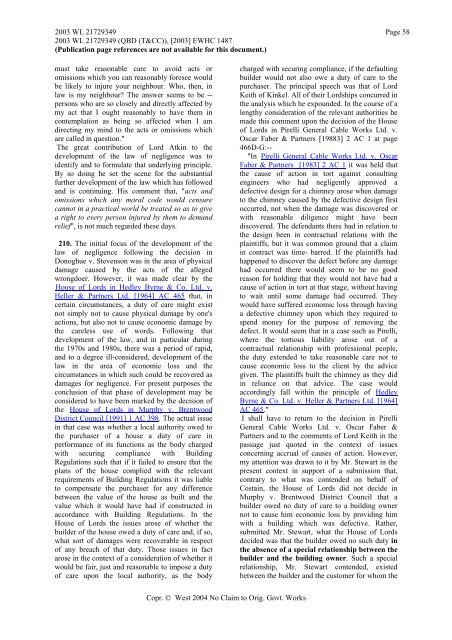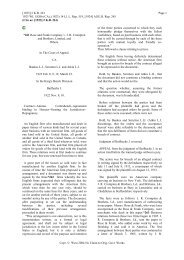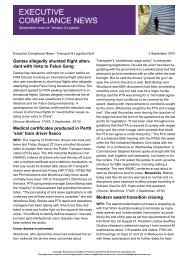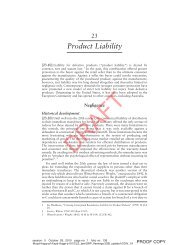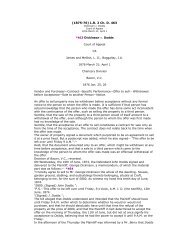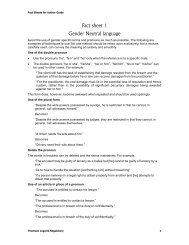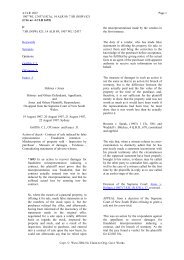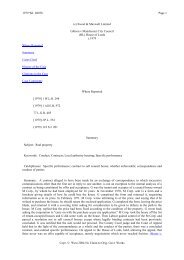Tesco v Constain - Thomson Reuters
Tesco v Constain - Thomson Reuters
Tesco v Constain - Thomson Reuters
Create successful ePaper yourself
Turn your PDF publications into a flip-book with our unique Google optimized e-Paper software.
2003 WL 21729349 Page 582003 WL 21729349 (QBD (T&CC)), [2003] EWHC 1487(Publication page references are not available for this document.)must take reasonable care to avoid acts oromissions which you can reasonably foresee wouldbe likely to injure your neighbour. Who, then, inlaw is my neighbour? The answer seems to be --persons who are so closely and directly affected bymy act that I ought reasonably to have them incontemplation as being so affected when I amdirecting my mind to the acts or omissions whichare called in question."The great contribution of Lord Atkin to thedevelopment of the law of negligence was toidentify and to formulate that underlying principle.By so doing he set the scene for the substantialfurther development of the law which has followedand is continuing. His comment that, "acts andomissions which any moral code would censurecannot in a practical world be treated so as to givea right to every person injured by them to demandrelief", is not much regarded these days.210. The initial focus of the development of thelaw of negligence following the decision inDonoghue v. Stevenson was in the area of physicaldamage caused by the acts of the allegedwrongdoer. However, it was made clear by theHouse of Lords in Hedley Byrne & Co. Ltd. v.Heller & Partners Ltd. [1964] AC 465 that, incertain circumstances, a duty of care might existnot simply not to cause physical damage by one'sactions, but also not to cause economic damage bythe careless use of words. Following thatdevelopment of the law, and in particular duringthe 1970s and 1980s, there was a period of rapid,and to a degree ill-considered, development of thelaw in the area of economic loss and thecircumstances in which such could be recovered asdamages for negligence. For present purposes theconclusion of that phase of development may beconsidered to have been marked by the decision ofthe House of Lords in Murphy v. BrentwoodDistrict Council [1991] 1 AC 398. The actual issuein that case was whether a local authority owed tothe purchaser of a house a duty of care inperformance of its functions as the body chargedwith securing compliance with BuildingRegulations such that if it failed to ensure that theplans of the house complied with the relevantrequirements of Building Regulations it was liableto compensate the purchaser for any differencebetween the value of the house as built and thevalue which it would have had if constructed inaccordance with Building Regulations. In theHouse of Lords the issues arose of whether thebuilder of the house owed a duty of care and, if so,what sort of damages were recoverable in respectof any breach of that duty. Those issues in factarose in the context of a consideration of whether itwould be fair, just and reasonable to impose a dutyof care upon the local authority, as the bodycharged with securing compliance, if the defaultingbuilder would not also owe a duty of care to thepurchaser. The principal speech was that of LordKeith of Kinkel. All of their Lordships concurred inthe analysis which he expounded. In the course of alengthy consideration of the relevant authorities hemade this comment upon the decision of the Houseof Lords in Pirelli General Cable Works Ltd. v.Oscar Faber & Partners [19883] 2 AC 1 at page466D-G:--"In HPirelli General Cable Works Ltd. v. OscarFaber & Partners [1983] 2 AC 1 it was held thatthe cause of action in tort against consultingengineers who had negligently approved adefective design for a chimney arose when damageto the chimney caused by the defective design firstoccurred, not when the damage was discovered orwith reasonable diligence might have beendiscovered. The defendants there had in relation tothe design been in contractual relations with theplaintiffs, but it was common ground that a claimin contract was time- barred. If the plaintiffs hadhappened to discover the defect before any damagehad occurred there would seem to be no goodreason for holding that they would not have had acause of action in tort at that stage, without havingto wait until some damage had occurred. Theywould have suffered economic loss through havinga defective chimney upon which they required tospend money for the purpose of removing thedefect. It would seem that in a case such as Pirelli,where the tortious liability arose out of acontractual relationship with professional people,the duty extended to take reasonable care not tocause economic loss to the client by the advicegiven. The plaintiffs built the chimney as they didin reliance on that advice. The case wouldaccordingly fall within the principle of HedleyByrne & Co. Ltd. v. Heller & Partners Ltd. [1964]AC 465."I shall have to return to the decision in PirelliGeneral Cable Works Ltd. v. Oscar Faber &Partners and to the comments of Lord Keith in thepassage just quoted in the context of issuesconcerning accrual of causes of action. However,my attention was drawn to it by Mr. Stewart in thepresent context in support of a submission that,contrary to what was contended on behalf ofCostain, the House of Lords did not decide inMurphy v. Brentwood District Council that abuilder owed no duty of care to a building ownernot to cause him economic loss by providing himwith a building which was defective. Rather,submitted Mr. Stewart, what the House of Lordsdecided was that the builder owed no such duty inthe absence of a special relationship between thebuilder and the building owner. Such a specialrelationship, Mr. Stewart contended, existedbetween the builder and the customer for whom theCopr. © West 2004 No Claim to Orig. Govt. Works


